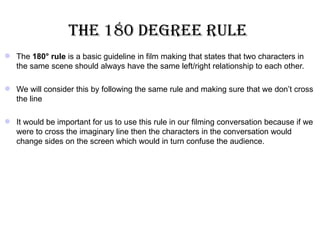Assignment 5 planning for preliminary
- 1. Anicia Brown, Annie Tagoe & Ursula Otieno Preliminary Task
- 2. Brainstorm Somebody walks up to the door, opens the door, walks into the room sits down and has a conversation with her friend about what they did in the weekend. Somebody walks in to room, knocks on the door, opens the door and walks in the room opposite takes at seat and in front of the doctor and tell the doctor she hasn’t been well. Somebody walks up to the door, opens the door, comes into the class room and has a conversation with her friend about her holiday Somebody walks up to the door, opens the door, walks into the kitchen and has a conversation with her mum about breaking up with her boyfriend.
- 3. the 180 degree rule The 180° rule is a basic guideline in film making that states that two characters in the same scene should always have the same left/right relationship to each other. We will consider this by following the same rule and making sure that we don’t cross the line It would be important for us to use this rule in our filming conversation because if we were to cross the imaginary line then the characters in the conversation would change sides on the screen which would in turn confuse the audience.
- 4. match on action Match on action is a technique which is used to give the viewer the illusion of one single movement across two separate shots. For example, if you filmed someone catching a ball, you would show a mid- shot showing the whole of the persons upper body and the persons arm begin to move. The next shot would be from a different angle, but would continue to show the person catching the ball. It is very important that the person is catching the ball at the same speed in both shots so that the action looks fluid. This technique is often very difficult to master, because it requires both camera shots and editing to match perfectly.
- 5. establishing close up extreme 2 shot over the shot close up shoulder shot Visual A wide shot Tightly frames The extreme when two This shot is What is it that covers the a person or an close up shot is people are in framed from used for whole room or background, object. Close- ups display the used to reveal very small the same frame. E.g. behind a person who is and used to set the most detail, details in the People having looking at the scene, and tell Close-ups are scene. The a conversation, subject. This why? the viewer often used as subject, or a fighting. shot helps to visually where cutaways from certain feature establish the the scene will a more distant or part of the position of each be taking place. shot to show subject, fills the person, and get Almost always detail, such as screen and is the feel of placed at the characters' clearly the looking at one beginning of emotions, or central focus of person from the the scene. some intricate the shot. other's point of activity with view. their hands.
- 7. draft 1
- 8. final draft
- 9. final draft
- 10. Script changes With our first draft we didn’t add any emotions of how the character was feeling, we also didn’t add stage directions and what the camera shots will be. Whereas in our final draft we included stage direction so everyone on set knows what we’re doing. We also included camera shots directions so it makes it easy for the camera crew, as they know what they’re doing. We also emotions so that the audience can get in touched with the characters feelings.











